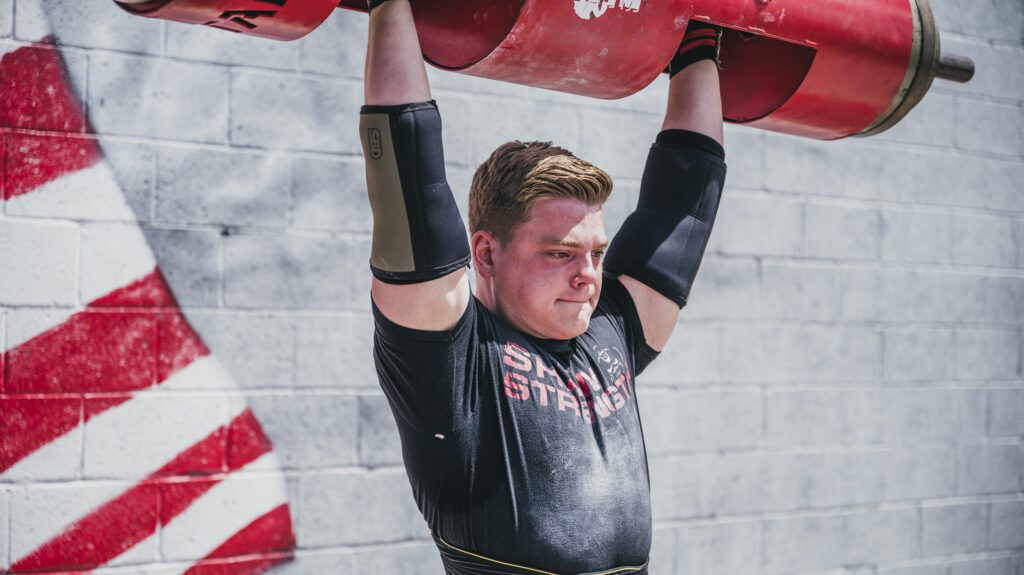
Athlete presses a large steal or wood log with two hands. The event can be done for 1) maximum load, 2) As many reps as possible for time, 0r 3) As one of 2 or more implements in a medley of lifts/movements.
LOG CLEAN AND PRESS: (MAX LOAD)
-For Maximum weight selected by the athlete.
-3 total attempts at max load.
-Two failed attempts will eliminate the athlete from the event.
-60 second time limit per attempt.
-8” to 12” diameter log with handles set 24” to 29” apart.
-Athlete may strict press, push press, push jerk or split jerk the log overhead to the locked out position.
-Athlete must wait for the “good” command before lowering the log.
-The athlete must lower the log under control. No deliberate dropping of the log will be permitted. The athlete may forfeit his attempt in doing so.
-Good Lift: Log locked out under control overhead with arms straight, head thru, legs and feet parallel and stationary.
-Equipment allowed: Belt, chalk, wrist wraps, elbow sleeves, knee wraps or sleeves.
-Equipment NOT allowed: Any item placed within the belt to provide a “shelf”. Back of belt built up to no more than 8” wide. Tacky, elbow wraps.
-Any and all anatomical limitations preventing a lockout as described above must be demonstrated to the judges prior to the start of the event. This is solely the responsibility of the athlete.
LOG CLEAN AND PRESS: (AMRAP)
-For as many rounds as possible for time.
-Weight is based on the athletes class.
-Athletes are each given 60 seconds.
-Athletes can continue to add reps from either arm in their allotted time as long as they don’t leave the platform or lose control of the log.
-Log is taken from the floor or crash pads and lifted over head with arms straight, head thru, legs and feet parallel and stationary.
-8” to 12” diameter log with handles set 24” to 29” apart.
-Athlete may strict press, push press, push jerk or split jerk the log overhead to the locked out position.
-Athlete must wait for the “good” command before lowering the log.
-The athlete must lower the log under control. No deliberate dropping of the log will be permitted. The athlete may forfeit his attempt in doing so.
-Good Lift: Log locked out under control overhead with arms straight, head thru, legs and feet parallel and stationary.
-Equipment allowed: Belt, chalk, wrist wraps, elbow sleeves, knee wraps or sleeves.
-Equipment NOT allowed: Any item placed within the belt to provide a “shelf”. Back of belt built up to no more than 8” wide. Tacky, elbow wraps.
-Any and all anatomical limitations preventing a lockout as described above must be demonstrated to the judges prior to the start of the event. This is solely the responsibility of the athlete.
LOG CLEAN AND PRESS: (Medley)
-Requirements for this event vary from competition to competition.
-Complete one or more reps before moving on to the next event in the medley.
-This event may be used in any order of the promoters choosing.
-Read the rules of each competition very carefully for the order of events and if you are required to complete the lift before moving on to another lift in the medley.
-The goal of a medley is to complete as many of the implements as quickly as possible.
-These medleys are typically given a 60 to 90-second time limit.
-Log is taken from the floor or crash pads and lifted over head with arms straight, head thru, legs and feet parallel and stationary.
-8” to 12” diameter log with handles set 24” to 29” apart.
-Athlete may strict press, push press, push jerk or split jerk the log overhead to the locked out position.
-Athlete must wait for the “good” command before lowering the log.
-The athlete must lower the log under control. No deliberate dropping of the log will be permitted. The athlete may forfeit his attempt in doing so.
-Good Lift: Log locked out under control overhead with arms straight, head thru, legs and feet parallel and stationary.
-Equipment allowed: Belt, chalk, wrist wraps, elbow sleeves, knee wraps or sleeves.
-Equipment NOT allowed: Any item placed within the belt to provide a “shelf”. Back of belt built up to no more than 8” wide. Tacky, elbow wraps.
-Any and all anatomical limitations preventing a lockout as described above must be demonstrated to the judges prior to the start of the event. This is solely the responsibility of the athlete.


